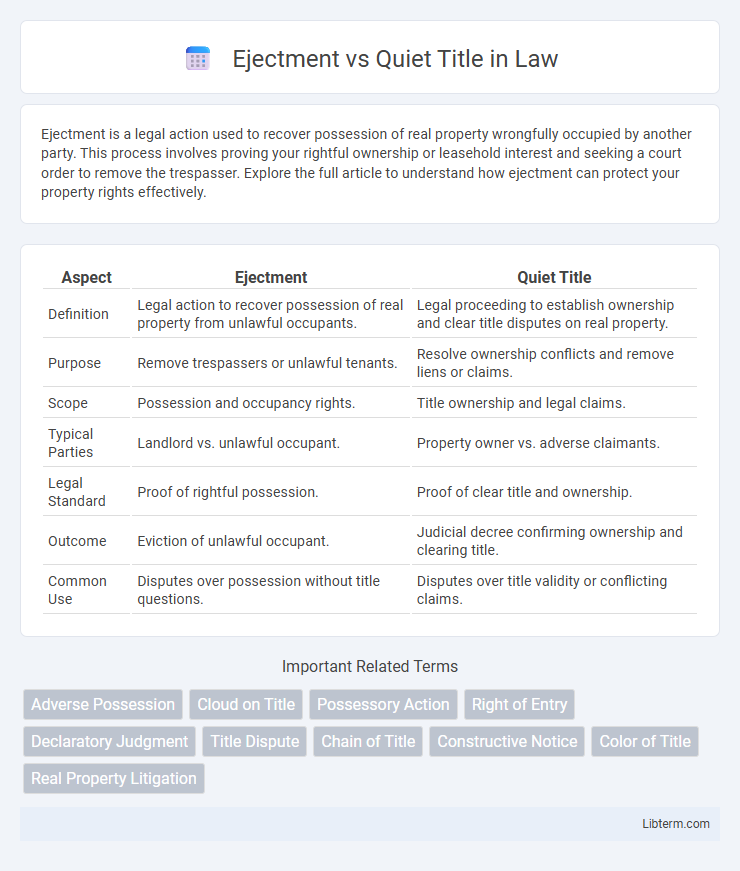Ejectment is a legal action used to recover possession of real property wrongfully occupied by another party. This process involves proving your rightful ownership or leasehold interest and seeking a court order to remove the trespasser. Explore the full article to understand how ejectment can protect your property rights effectively.
Table of Comparison
| Aspect | Ejectment | Quiet Title |
|---|---|---|
| Definition | Legal action to recover possession of real property from unlawful occupants. | Legal proceeding to establish ownership and clear title disputes on real property. |
| Purpose | Remove trespassers or unlawful tenants. | Resolve ownership conflicts and remove liens or claims. |
| Scope | Possession and occupancy rights. | Title ownership and legal claims. |
| Typical Parties | Landlord vs. unlawful occupant. | Property owner vs. adverse claimants. |
| Legal Standard | Proof of rightful possession. | Proof of clear title and ownership. |
| Outcome | Eviction of unlawful occupant. | Judicial decree confirming ownership and clearing title. |
| Common Use | Disputes over possession without title questions. | Disputes over title validity or conflicting claims. |
Introduction to Ejectment and Quiet Title
Ejectment is a legal action used to recover possession of real property wrongfully occupied by another party, emphasizing the removal of trespassers or unlawful tenants. Quiet title actions resolve disputes over property ownership by clearing any clouds or claims on the title, establishing clear and marketable ownership rights. Both remedies serve distinct purposes in property law: ejectment addresses possession issues, while quiet title secures ownership.
Legal Definitions: Ejectment vs Quiet Title
Ejectment is a legal action used to recover possession of real property wrongfully occupied by another party, focusing on the removal of trespassers and restoring possession to the rightful owner. Quiet title, by contrast, is a lawsuit that establishes ownership by resolving disputes or claims affecting title to real property, thereby "quieting" any challenges or clouds on the title. Both actions serve distinct purposes: ejectment addresses possession rights, while quiet title confirms and clears legal ownership.
Purpose and Scope of Ejectment Actions
Ejectment actions primarily serve to remove unlawful occupants and recover possession of real property, focusing on disputes involving wrongful possession or tenancy. Quiet title actions aim to resolve competing ownership claims by establishing clear title and removing cloud on property title. The scope of ejectment is narrower, targeting possession issues, while quiet title addresses ownership and title clarity.
Purpose and Scope of Quiet Title Actions
Quiet Title actions establish clear ownership of real property by resolving disputes or claims on the title. These lawsuits remove any cloud or lien affecting the title to ensure legal clarity and marketability. Unlike ejectment, which focuses on removing a wrongful occupant, quiet title secures and affirms rightful ownership against all competing interests.
Key Differences Between Ejectment and Quiet Title
Ejectment is a legal action aimed at recovering possession of real property wrongfully occupied by another party, focusing primarily on establishing the right to possess the land. Quiet title, by contrast, resolves disputes over property ownership and clears any competing claims or liens, providing a definitive title free from encumbrances. The key difference lies in ejectment targeting possession issues, while quiet title addresses ownership and title clarity.
Legal Requirements for Filing Each Action
Ejectment requires proving rightful possession, typically involving a lease, deed, or contract to demonstrate unlawful possession by the defendant. Quiet title actions demand establishing ownership through clear title evidence, such as deeds, tax records, or chain of title documents, to remove clouds or disputes on property ownership. Both actions must be filed in the appropriate jurisdiction with proper legal descriptions of the property and adherence to state-specific procedural rules for filing and service.
Typical Scenarios for Ejectment Cases
Ejectment cases typically arise when a property owner seeks to remove a tenant or occupant who refuses to vacate after the lease has expired or been terminated, often involving disputes over possession rather than ownership. These cases also occur when a trespasser or squatter occupies land without permission, prompting the rightful owner to regain possession through legal means. Unlike quiet title actions, which resolve ownership disputes, ejectment focuses primarily on recovering physical possession of real property.
Typical Scenarios for Quiet Title Cases
Quiet title cases typically arise when property owners face disputes over ownership due to unclear or conflicting records, such as after a foreclosure, tax sale, or inheritance issue. They are commonly used to resolve encroachments, boundary disputes, or claims from adverse possession to establish clear legal title. Unlike ejectment actions, quiet title suits focus on removing any clouds or defects on the title rather than seeking possession of real property.
Outcomes and Remedies in Ejectment and Quiet Title
Ejectment resolves disputes by removing unlawful occupants from property, resulting in possession restoration and potential damages for trespass. Quiet title actions establish clear legal ownership, eliminating adverse claims and liens to secure marketable title. Remedies in ejectment focus on physical possession and eviction, while quiet title primarily remedies title defects and clouded ownership rights.
Choosing the Right Legal Action: Ejectment or Quiet Title
Choosing between ejectment and quiet title actions depends on the nature of the property dispute; ejectment is suited for recovering possession of real property where illegal occupation occurs, while quiet title establishes clear ownership by removing competing claims. Ejectment requires proof of right to possess and typically resolves possession disputes quickly, whereas quiet title suits long-term ownership clarification, often involving complex title defects or clouded ownership histories. Evaluating the goal--possession recovery or title clarity--is critical for selecting the appropriate legal remedy in real estate conflicts.
Ejectment Infographic

 libterm.com
libterm.com